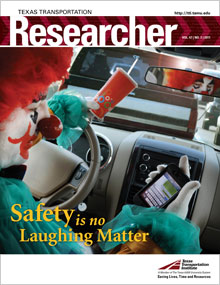Helping the Rail Industry Get on the Right Track

To lessen the number and severity of train incidents, the Texas Transportation Institute’s (TTI’s) Rail Research Program is developing course materials for the Long Island Rail Road (LIRR), the oldest and busiest passenger railroad still operating under its original name and charter in the United States.
“LIRR management is taking a very proactive approach to changing its culture and improving safety,” says Curtis Morgan, TTI Multimodal Freight Transportation Program manager. “This is the beginning of the process . . . but will be spread to the various groups within the company.”
To create the course materials, TTI is building upon the team safety concept of crew resource management (CRM), first developed by NASA and the commercial airline industry. CRM’s original purpose was to help avoid crashes resulting from pilot error by identifying and preventing potential problems before they occur or by mitigating the effects of minor errors before they result in a major incident. Research showed that many crashes resulted not from operator error, but from poor communication and resource coordination among flight crew members. CRM addresses these fundamental problems by emphasizing a teamwork approach to improving safety. Time has proven the value of CRM to the airline industry via improvements in crew member proficiency, communication and teamwork, conflict resolution, and the maintaining of situational awareness.
Rail industry leaders began adapting CRM to their own needs, though until recently those efforts were largely limited to training engineers and conductors. TTI’s approach will widen the training to the larger teams supporting passenger movement, specifically in the area served by LIRR.
“Sometimes, rail crews become so bogged down with their own individual assignments, they lose sight of the big picture,” says TTI Associate Research Scientist Les Olson, head of the LIRR project. “This team-based concept will help railroad personnel anticipate, prevent and minimize incidents.”
The current project builds on research conducted by TTI from 2002 to 2007. At that time, the Federal Railroad Administration sponsored TTI to conduct an assessment of rail industry needs regarding CRM. The Institute studied railroads, including Class I railroads, a shortline/regional railroad, a commuter railroad and the national intercity passenger railroad (Amtrak). This survey yielded quantifiable characteristics of how teams work together across the industry.
TTI also found that combining cognitive training methods (e.g., traditional and multimedia-based instruction, computer-based training, and written exercises) with behavioral training methods (e.g., roleplaying, group exercises and simulation) yields the most effective instruction. Subsequent studies included a pilot test of the TTI-developed CRM curriculum at BNSF Railway and a business-case study to show the potential value of implementing CRM in the railroad industry.
Olson explains that once the LIRR management personnel have received the new training, LIRR will provide CRM training to their remaining employees. The project is expected to last one to two years as the CRM materials are developed and adopted into LIRR’s existing training programs.

